Clothing
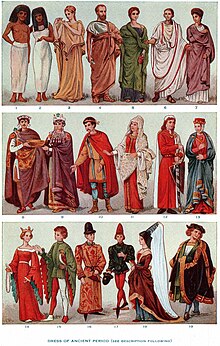

Clothing(also known asclothes,garments,dress,apparel,orattire) is any item worn on thebody.Typically, clothing is made of fabrics ortextiles,but over time it has included garments made from animal skin and other thin sheets of materials and natural products found in the environment, put together. The wearing of clothing is mostly restricted tohuman beingsand is a feature of all human societies. The amount and type of clothing worn depends on gender, body type, social factors, and geographic considerations. Garments cover the body,footwearcovers the feet,glovescover the hands, whilehatsandheadgearcover the head, andunderwearcovers theprivate parts.
Clothing serves many purposes: it can serve as protection from the elements, rough surfaces, sharp stones, rash-causing plants, and insect bites, by providing a barrier between the skin and the environment. Clothing can insulate against cold or hot conditions, and it can provide ahygienicbarrier, keeping infectious and toxic materials away from the body. It can protect feet from injury and discomfort or facilitate navigation in varied environments. Clothing also provides protection fromultraviolet radiation.It may be used to prevent glare or increase visual acuity in harsh environments, such as brimmed hats. Clothing is used for protection against injury in specific tasks and occupations, sports, and warfare. Fashioned with pockets,belts,or loops, clothing may provide a means to carry things while freeing the hands.
Clothing has significant social factors as well. Wearing clothes is a variablesocial norm.It may connotemodesty.Being deprived of clothing in front of others may beembarrassing.In many parts of the world, not wearing clothes in public so thatgenitals,breast,orbuttocksare visible could be consideredindecent exposure.Pubic area or genital coverage is the most frequently encountered minimum found cross-culturally and regardless of climate, implyingsocial conventionas the basis of customs. Clothing also may be used to communicate social status, wealth, group identity, and individualism.
Some forms ofpersonal protective equipmentamount to clothing, such ascoveralls,chapsor a doctor'swhite coat,with similar requirements for maintenance andcleaningas other textiles (boxing glovesfunction both as protective equipment and as asparringweapon,so the equipment aspect rises above the glove aspect). More specialized forms of protective equipment, such asface shieldsare classified as protective accessories. At the far extreme, self-enclosingdiving suitsorspace suitsareform-fittingbody covers, and amount to a form of dress, without being clothing per se, while containing enough high technology to amount to more of a tool than a garment. This line will continue to blur aswearable technologyembeds assistive devices directly into the fabric itself; the enabling innovations are ultralow power consumptionandflexible electronic substrates.
Clothing also hybridizes into a personal transportation system (ice skates,roller skates,cargo pants,other outdoorsurvival gear,one-man band) orconcealmentsystem (stage magicians,hidden linings orpocketsintradecraft,integrated holsters forconcealed carry,merchandise-ladentrench coatson theblack market— where the purpose of the clothing often carries over intodisguise). A mode of dress fit to purpose, whether stylistic or functional, is known as an outfit or ensemble.
Origin and history
[edit]
Early use
[edit]Estimates of when humans began wearing clothes vary from 40,000 to as many as 3 million years ago, but recent studies suggest humans were wearing clothing at least 100,000 years ago.
Recent studies by Ralf Kittler, Manfred Kayser and Mark Stoneking—anthropologistsat theMax Planck Institute for Evolutionary Anthropology—have attempted to constrain the most recent date of the introduction of clothing with an indirect method relying onlice.The rationale for this method of dating stems from the fact that the human body louse cannot live outside of clothing, dying after only a few hours without shelter. This strongly implies that the date of the body louse's speciation from its parent,Pediculus humanus,can have taken place no earlier than the earliest human adoption of clothing. This date, at which the body louse (P. humanus corporis) diverged from both its parent species and its sibling subspecies, the head louse (P. humanus capitis), can be determined by the number of mutations each has developed during the intervening time. Such mutations occur at a known rate and the date of last-common-ancestor for two species can therefore be estimated from their frequency. These studies have produced dates from 40,000 to 170,000 years ago, with a greatest likelihood of speciation lying at about 107,000 years ago.[1]
Kittler, Kayser and Stoneking suggest that the invention of clothing may have coincided with the northward migration of modernHomo sapiensaway from the warmclimateof Africa, which is thought to have begun between 100,000 and 50,000 years ago. A second group of researchers, also relying on the genetic clock, estimate that clothing originated between 30,000 and 114,000 years ago.[2]
Dating with direct archeological evidence produces dates consistent with those of lice. In September 2021, scientists reported evidence of clothes being made 120,000 years ago based on findings in deposits inMorocco.[3][4]
According to Anthropologists and Archaeologists, the earliest clothing likely consisted offur,leather, leaves, or grass that was draped, wrapped, or tied around the body. Knowledge of such clothing remains inferential, asclothing materialsdeteriorate quickly compared with stone, bone, shell, and metal artifacts. Archeologists have identified very earlysewing needlesof bone and ivory from about 30,000 BC, found nearKostenki,Russia in 1988,[5]and in 2016 a needle at least 50,000 years old from Denisova Cave in Siberia[6]made byDenisovans.Dyedflaxfibers that date back to 34,000 BC and could have been used in clothing have been found in a prehistoric cave inGeorgia.[7][8]
Making clothing
[edit]Several distinct human cultures, including those residing in the Arctic Circle, have historically crafted their garments exclusively from treated and adorned animal furs and skins. In contrast, numerous other societies have complemented or substituted leather and skins with textiles woven, knitted, or twined from a diverse array of animal and plant fibers, such as wool, linen, cotton, silk, hemp, and ramie.
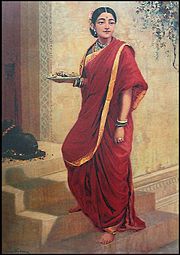
Although modern consumers may take the production of clothing for granted, making fabric by hand is a tedious and labor-intensive process involving fiber making, spinning, and weaving. The textile industry was the first to be mechanized – with thepowered loom– during theIndustrial Revolution.
Different cultures have evolved various ways of creating clothes out of cloth. One approach involves draping the cloth. Many people wore, and still wear, garments consisting of rectangles of cloth wrapped to fit – for example, thedhotifor men and thesarifor women in theIndian subcontinent,the Scottishkilt,and the Javanesesarong.The clothes may be tied up (dhoti and sari) or implement pins or belts to hold the garments in place (kilt and sarong). The cloth remains uncut, and people of varioussizescan wear the garment.
Another approach involves measuring, cutting, and sewing the cloth by hand or with asewing machine.Clothing can be cut from asewing patternand adjusted by a tailor to the wearer's measurements. An adjustable sewing mannequin ordress formis used to create form-fitting clothing. If the fabric is expensive, the tailor tries to use every bit of the cloth rectangle in constructing the clothing; perhaps cutting triangular pieces from one corner of the cloth, and adding them elsewhere asgussets.Traditional European patterns for shirts andchemisestake this approach. These remnants can also be reused to make patchwork pockets, hats,vests,andskirts.
Modern European fashion treats cloth much less conservatively, typically cutting in such a way as to leave various odd-shaped cloth remnants. Industrial sewing operations sell these as waste; domestic sewers may turn them intoquilts.
In the thousands of years that humans have been making clothing, they have created an astonishing array of styles, many of which have been reconstructed from surviving garments, photographs, paintings,mosaics,etc., as well as from written descriptions. Costume history can inspire current fashion designers, as well as costumiers for plays, films, television, andhistorical reenactment.
Clothing as comfort
[edit]
Comfortis related to various perceptions, physiological, social, and psychological needs, and after food, it is clothing that satisfies these comfort needs. Clothing provides aesthetic, tactile, thermal, moisture, and pressure comfort.[9]
- Aesthetic comfort
- Visual perception is influenced bycolor,fabric construction, style, garment fit, fashion compatibility, and finish of clothing material. Aesthetic comfort is necessary for psychological and social comfort.[10][11][12]
- Thermoregulationand thermophysiological comfort
- Thermophysiological comfort is the capacity of the clothing material that makes the balance of moisture and heat between the body and the environment. It is a property of textile materials that creates ease by maintaining moisture and thermal levels in a human's resting and active states. The selection of textile material significantly affects the comfort of the wearer. Different textile fibers have unique properties that make them suitable for use in various environments. Natural fibers are breathable and absorb moisture, and synthetic fibers are hydrophobic; they repel moisture and do not allow air to pass.:: Different environments demand a diverse selection of clothing materials. Hence, the appropriate choice is important.[13][14][15][16][17][18][19]The major determinants that influence thermophysiological comfort are permeable construction, heat, and moisture transfer rate.[20]
- Thermal comfort
- One primary criterion for our physiological needs is thermal comfort. The heat dissipation effectiveness of clothing gives the wearer a neither very hot nor very cold feel. The optimum temperature for thermal comfort of the skin surface is between 28 and 30 °C (82 and 86 °F), i.e., a neutral temperature. Thermophysiology reacts whenever the temperature falls below or exceeds the neutral point on either side; it is discomforting below 28 and above 30 degrees.[21]Clothing maintains a thermal balance; it keeps the skin dry and cool. It helps to keep the body from overheating while avoiding heat from the environment.[22][23]
- Moisture comfort
- Moisture comfort is the prevention of a damp sensation. According to Hollies' research, it feels uncomfortable when more than "50% to 65% of the body is wet."[24]
- Tactilecomfort
- Tactile comfort is a resistance to the discomfort related to the friction created by clothing against the body. It is related to the smoothness, roughness, softness, and stiffness of the fabric used in clothing. The degree of tactile discomfort may vary between individuals, which is possible due to various factors including allergies, tickling, prickling, skin abrasion, coolness, and the fabric's weight, structure, and thickness. There are specific surface finishes (mechanical and chemical) that can enhance tactile comfort. Fleece sweatshirts and velvet clothing, for example. Soft, clingy, stiff, heavy, light, hard, sticky, scratchy, prickly are all terms used to describe tactile sensations.[25][26][27][28]
- Pressure comfort
- The comfort of the human body's pressure receptors' (present in the skin) sensory response towards clothing. Fabric with lycra feels more comfortable because of this response and superior pressure comfort. The sensation response is influenced by the material's structure: snugging, looseness, heavy, light, soft, or stiff structuring.[29][30]
Functions
[edit]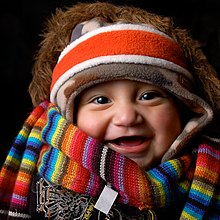
The most obvious function of clothing is to protect the wearer from the elements. It serves to prevent wind damage and provides protection fromsunburn.In the cold, it offersthermal insulation.Shelter can reduce the functional need for clothing. For example,coats,hats, gloves, and other outer layers are normally removed when entering a warm place. Similarly, clothing has seasonal and regional aspects so that thinner materials and fewer layers of clothing generally are worn in warmer regions and seasons than in colder ones. Boots, hats, jackets, ponchos, and coats designed to protect from rain and snow are specialized clothing items.
Clothing has been made from a wide variety of materials, ranging from leather andfursto woven fabrics, to elaborate and exotic natural andsynthetic fabrics.Not all body coverings are regarded as clothing. Articles carried rather than worn normally are consideredaccessoriesrather than clothing (such asHandbags), items worn on a single part of the body and easily removed (scarves), worn purely for adornment (jewelry), or items that do not serve a protective function. For instance, correctiveeyeglasses,Arcticgoggles,andsunglasseswould not be considered an accessory because of their protective functions.
Clothing protects against many things that might injure or irritate the naked human body, including rain, snow, wind, and other weather, as well as from the sun. Garments that are too sheer, thin, small, or tight offer less protection. Appropriate clothes can also reduce risk during activities such as work or sport. Some clothing protects from specific hazards, such as insects, toxic chemicals, weather,weapons,and contact with abrasive substances.
Humans have devised clothing solutions to environmental or other hazards: such asspace suits,armor,diving suits,swimsuits,bee-keeper gear,motorcycle leathers,high-visibility clothing,and other pieces ofprotective clothing.The distinction between clothing and protective equipment is not always clear-cut since clothes designed to be fashionable often have protective value, and clothes designed for function often have corporate fashion in their design.
The choice of clothes also has social implications. They cover parts of the body that social norms require to be covered, act as a form of adornment, and serve other social purposes. Someone who lacks the means to procure appropriate clothing due to poverty or affordability, or lack of inclination, sometimes is said to be worn, ragged, or shabby.[31]
Clothing performs a range of social andculturalfunctions, such as individual, occupational, gender differentiation, and social status.[32]In many societies, norms about clothing reflect standards ofmodesty,religion,gender,andsocial status.Clothing may also function as adornment and an expression of personal taste or style.
Scholarship
[edit]Function of clothing
[edit]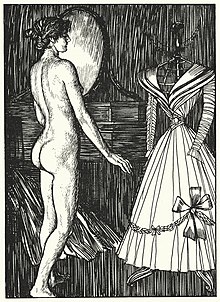
Serious books on clothing and its functions appear from the nineteenth century asEuropean colonial powersinteracted with new environments such as tropical ones in Asia.[33]Some scientific research into the multiple functions of clothing in the first half of the twentieth century, with publications such asJ.C. Flügel'sPsychology of Clothesin 1930,[32]and Newburgh's seminalPhysiology of Heat Regulation and The Science of Clothingin 1949.[34]By 1968, the field of Environmental Physiology had advanced and expanded significantly, but the science of clothing in relation to environmental physiology had changed little.[35]There has since been considerable research, and the knowledge base has grown significantly, but the main concepts remain unchanged, and indeed, Newburgh's book continues to be cited by contemporary authors, including those attempting to develop thermoregulatory models of clothing development.[36]
History of clothing
[edit]
Clothing reveals much about human history. According to Professor Kiki Smith of Smith College, garments preserved in collections are resources for study similar to books and paintings.[37]Scholars around the world have studied a wide range of clothing topics, including the history of specific items of clothing,[38][39]clothing styles in different cultural groups,[40]and the business of clothing and fashion.[41]The textile curator Linda Baumgarten writes that "clothing provides a remarkable picture of the daily lives, beliefs, expectations, and hopes of those who lived in the past.[42]
Clothing presents a number of challenges to historians. Clothing made of textiles or skins is subject to decay, and the erosion of physical integrity may be seen as a loss of cultural information.[43]Costume collections often focus on important pieces of clothing considered unique or otherwise significant, limiting the opportunities scholars have to study everyday clothing.[37]
Cultural aspects
[edit]Gender differentiation
[edit]
-
Japanese PMShinzō AbeandIvanka Trump(right) wearing Western-style gender-differentiatedbusiness suits(2017)
-
Italian actorsGabriel Garkoin asuitandLaura Torrisiin agown,consideredRed carpet fashionby designerdress code(2009)
-
3rd Duke of Fife wearing a traditionalScottish kilt(1984)
In most cultures, gender differentiation of clothing is considered appropriate. The differences are in styles, colors, fabrics, and types.
In contemporary Western societies,skirts,dresses,andhigh-heeled shoesare usually seen as women's clothing, while neckties usually are seen as men's clothing.Trouserswere once seen as exclusively men's clothing, but nowadays are worn by both genders. Men's clothes are often more practical (that is, they can function well under a wide variety of situations), but a wider range of clothing styles is available for women. Typically, men are allowed tobare their chestsin a greater variety of public places. It is generally common for a woman to wear clothing perceived as masculine, while the opposite is seen as unusual. Contemporary men may sometimes choose to wearmen's skirtssuch astogasorkiltsin particular cultures, especially on ceremonial occasions. In previous times, such garments often were worn as normal daily clothing by men.
In some cultures,sumptuary lawsregulate what men and women are required to wear.Islamrequires women to wear certain forms of attire, usuallyhijab.What items required varies in different Muslim societies; however, women are usually required to cover more of their bodies than men. Articles of clothing Muslim women wear under these laws or traditions range from thehead-scarfto theburqa.
Some contemporary clothing styles designed to be worn by either gender, such as T-shirts, have started out as menswear, but some articles, such as thefedora,originally were a style for women.
Social status
[edit]-
Achkansherwaniandchuridar(lower body) worn byArvind Singh Mewarand his kin during aHindu weddinginRajasthan, India,are items traditionally worn by the elites of theIndian subcontinent
-
Abarong tagalogmade for a wedding ceremony
During theearly modern period,individuals utilized their attire as a significant method of conveying and asserting their social status. Individuals employed the utilization of high-quality fabrics and trendy designs as a means of communicating their wealth and social standing, as well as an indication of their knowledge and understanding of current fashion trends to the general public. As a result, clothing played a significant role in making the social hierarchy perceptible to all members of society.[44]
In some societies, clothing may be used to indicate rank orstatus.Inancient Rome,for example, only senators could wear garments dyed withTyrian purple.In traditionalHawaiiansociety, only high-ranking chiefs could wearfeather cloaksand palaoa, or carved whale teeth. In China, before establishment of therepublic,only the emperor could wear yellow. History provides many examples of elaboratesumptuary lawsthat regulated what people could wear. In societies without such laws, which includes most modern societies, social status is signaled by the purchase of rare or luxury items that are limited by cost to those with wealth or status. In addition,peer pressureinfluences clothing choice.
Religion
[edit]-
TheBuddhawearingkāṣāyarobes, originating fromancient India,these robes were worn by fully ordained Buddhist monks and nuns
Some religious clothing might be considered a special case of occupational clothing. Sometimes it is worn only during the performance of religious ceremonies. However, it may be worn every day as a marker for special religious status. Sikhs wear a turban as it is a part of their religion.
In some religions such asHinduism,Sikhism,Buddhism,andJainismthe cleanliness of religious dresses is of paramount importance and considered to indicate purity. Jewish ritual requires rending (tearing) of one's upper garment as a sign of mourning. The Quran says about husbands and wives, regarding clothing: "...They are clothing/covering (Libaas) for you; and you for them" (chapter 2:187).Christian clergymembers wear religiousvestmentsduringliturgicalservices and may wear specificnon-liturgical clothingat other times.
Clothing appears in numerous contexts in the Bible. The most prominent passages are: the story ofAdam and Evewho made coverings for themselves out offig leaves,Joseph'scoat of many colors,and the clothing ofJudahandTamar,MordecaiandEsther.Furthermore, the priests officiating in the Temple in Jerusalem had very specific garments, the lack of which made one liable to death.
Contemporary clothing
[edit]| Part ofa serieson |
| Western dress codes and correspondingattires |
|---|
|
Legend:
|
Western dress code
[edit]The Westerndress codehas changed over the past 500+ years. The mechanization of thetextile industrymade many varieties of cloth widely available at affordable prices. Styles have changed, and the availability ofsynthetic fabricshas changed the definition of what is "stylish". In the latter half of the twentieth century,blue jeansbecame very popular, and are now worn to events that normally demand formal attire.Activewearhas also become a large and growing market.
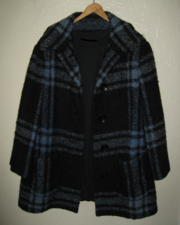
In the Western dress code, jeans are worn by both men and women. There are several unique styles of jeans found that include: high rise jeans, mid rise jeans, low rise jeans, bootcut jeans, straight jeans, cropped jeans, skinny jeans, cuffed jeans, boyfriend jeans, and capri jeans.
The licensing of designer names was pioneered by designers such asPierre Cardin,Yves Saint Laurent,andGuy Larochein the 1960s and has been a common practice within thefashion industryfrom about the 1970s. Among the more popular includeMarc JacobsandGucci,named for Marc Jacobs Guccio Gucci respectively.
Spread of western styles
[edit]
By the early years of the twenty-first century, western clothing styles had, to some extent, become international styles. This process began hundreds of years earlier, during the periods of Europeancolonialism.The process of cultural dissemination has been perpetuated over the centuries, spreading Western culture and styles, most recently as Western media corporations have penetrated markets throughout the world.Fast fashionclothing has also become a global phenomenon. These garments are less expensive, mass-produced Western clothing. Also, donatedusedclothing from Western countries is delivered to people in poor countries by charity organizations.
Ethnic and cultural heritage
[edit]People may wear ethnic ornational dresson special occasions or in certain roles or occupations. For example, most Korean men and women have adopted Western-style dress for daily wear, but still wear traditionalhanbokson special occasions, such as weddings and cultural holidays. Also, items ofWestern dressmay be worn or accessorized in distinctive, non-Western ways. A Tongan man may combine a usedT-shirtwith a Tongan wrapped skirt, ortupenu.
Sport and activity
[edit]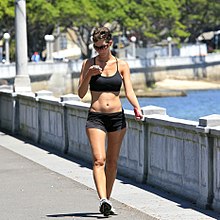
For practical, comfort or safety reasons, most sports and physical activities are practised wearing special clothing. Common sportswear garments includeshorts,T-shirts,tennis shirts,leotards,tracksuits,andtrainers.Specialized garments includewet suits(for swimming,diving,orsurfing),salopettes(forskiing), andleotards(for gymnastics). Also,spandexmaterials often are used as base layers to soak up sweat. Spandex is preferable for active sports that require form fitting garments, such as volleyball, wrestling, track and field, dance, gymnastics, and swimming.

Fashion
[edit]Paris set the 1900–1940 fashion trends for Europe and North America.[45]In the 1920s the goal was all about getting loose. Women wore dresses all day, every day. Day dresses had a drop waist, which was a sash or belt around the low waist or hip and a skirt that hung anywhere from the ankle on up to the knee, never above. Day wear had sleeves (long to mid-bicep) and a skirt that was straight, pleated, hank hemmed, or tiered. Jewelry was not conspicuous.[46]Hair was often bobbed, giving a boyish look.[47]
In the early twenty-first century a diverse range of styles exists in fashion, varying by geography, exposure to modern media, economic conditions, and ranging from expensivehaute couture,to traditional garb, tothrift storegrunge.Fashion showsare events for designers to show off new and often extravagant designs.
Political issues
[edit]Working conditions in the garments industry
[edit]

Althoughmechanizationtransformed most aspects of humanclothing industry,by the mid-twentieth century, garment workers have continued to labor under challenging conditions that demand repetitive manual labor. Often,mass-producedclothing is made in what are considered by some to besweatshops,typified by long work hours, lack of benefits, and lack of worker representation. While most examples of such conditions are found indeveloping countries,clothes made inindustrialized nationsmay also be manufactured under similar conditions.[48]
Coalitions of NGOs, designers (including Katharine Hamnett,American Apparel,Veja,Quiksilver,eVocal, and Edun), and campaign groups such as theClean Clothes Campaign(CCC) and theInstitute for Global Labour and Human Rightsas well astextile and clothing trade unionshave sought to improve these conditions by sponsoring awareness-raising events, which draw the attention of both the media and the general public to the plight of the workers.
Outsourcing production to low wage countries such asBangladesh,China, India,Indonesia,Pakistan,andSri Lankabecame possible when theMulti Fibre Agreement(MFA) was abolished. The MFA, which placed quotas on textiles imports, was deemed aprotectionistmeasure.[49]Although many countries recognize treaties such as theInternational Labour Organization,which attempt to set standards for worker safety and rights, many countries have made exceptions to certain parts of the treaties or failed to thoroughly enforce them. India for example has not ratified sections 87 and 92 of the treaty.
Theproduction of textileshas functioned as a consistent industry for developing nations, providing work and wages, whether construed as exploitative or not, to millions of people.[50]
Fur
[edit]The use of animal fur in clothing dates to prehistoric times. Currently, although fur is still used by indigenous people in arctic zones and higher elevations for its warmth and protection, in developed countries it is associated with expensive, designer clothing.[51][52]Once uncontroversial, recently it has been the focus of campaigns on the grounds that campaigners consider it cruel and unnecessary.PETAand otheranimalandanimal liberationgroups have called attention tofur farmingand other practices they consider cruel.
Real fur in fashion is contentious, with Copenhagen (2022)[53]and London (2018)[54]fashion weeks banning real fur in its runway shows following protests and government attention to the issue. Fashion houses such asGucciandChanelhave banned the use of fur in its garments.[55]VersaceandFurlaalso stopped using fur in their collections in early 2018. In 2020, the outdoor brandCanada Gooseannounced it would discontinue the use of new coyote fur on parka trims following protests.[56]
Governing bodies have issued legislation banning the sale of new real fur garments. In 2021, Israel was the first government to ban the sale of real fur garments, with the exception of those worn as part of a religious faith.[57]In 2019, the state of California banned fur trapping, with a total ban on the sale of all new fur garments except those made of sheep, cow, and rabbit fur going into effect on January 1, 2023.[58]
Life cycle
[edit]Clothing maintenance
[edit]Clothing suffers assault both from within and without. The human body sheds skin cells and body oils, and it exudes sweat, urine, and feces that may soil clothing. From the outside, sun damage, moisture, abrasion, and dirt assault garments. Fleas and lice can hide in seams. If not cleaned and refurbished, clothing becomes worn and loses itsaestheticsand functionality (as whenbuttonsfall off, seams come undone, fabrics thin or tear, andzippersfail).
Often, people wear an item of clothing until it falls apart. Some materials present problems. Cleaning leather is difficult, and bark cloth (tapa) cannot be washed without dissolving it. Owners may patch tears and rips, and brush off surface dirt, but materials such as these inevitably age.
Most clothing consists of cloth, however, and most cloth can belaunderedand mended (patching,darning,but comparefelt).
Laundry, ironing, storage
[edit]
Humans have developed many specialized methods for laundering clothing, ranging from early methods of pounding clothes against rocks in running streams, to the latest in electronicwashing machinesanddry cleaning(dissolving dirt insolventsother than water). Hot water washing (boiling), chemical cleaning, and ironing are all traditional methods ofsterilizingfabrics forhygienepurposes.
Many kinds of clothing are designed to beironedbefore they are worn to remove wrinkles. Most modern formal and semi-formal clothing is in this category (for example,dress shirtsandsuits). Ironed clothes are believed to look clean, fresh, and neat. Much contemporary casual clothing is made of knit materials that do not readily wrinkle, and do not require ironing. Some clothing ispermanent press,having been treated with a coating (such aspolytetrafluoroethylene) that suppresses wrinkles and creates a smooth appearance without ironing. Excess lint or debris may end up on the clothing in between launderings. In such cases, alint removermay be useful.
Once clothes have been laundered and possibly ironed, usually they are hung onclothes hangersor folded, to keep them fresh until they are worn. Clothes are folded to allow them to be stored compactly, to prevent creasing, to preserve creases, or to present them in a more pleasing manner, for instance, when they are put on sale in stores.
Certain types of insects and larvae feed on clothing and textiles, such as theblack carpet beetleandclothing moths.To deter such pests, clothes may be stored in cedar-lined closets or chests,[59]or placed in drawers or containers with materials having pest repellent properties, such aslavenderormothballs.Airtight containers (such as sealed, heavy-duty plastic bags) may deter insect pest damage to clothing materials as well.
Non-iron
[edit]A resin used for making non-wrinkle shirts releasesformaldehyde,which could cause contact dermatitis for some people; no disclosure requirements exist, and in 2008 the U.S.Government Accountability Officetested formaldehyde in clothing and found that generally the highest levels were in non-wrinkle shirts and pants.[60]In 1999, a study of the effect of washing on the formaldehyde levels found that after six months of routine washing, 7 of 27 shirts still had levels in excess of 75 ppm (the safe limit for direct skin exposure).[61]
Mending
[edit]When the raw material – cloth – was worth more than labor, it made sense to expend labor in saving it. In past times, mending was an art. A meticulous tailor orseamstresscould mend rips with thread raveled fromhemsand seam edges so skillfully that the tear was practically invisible. Today clothing is considered a consumable item. Mass-manufactured clothing is less expensive than the labor required to repair it. Many people buy a new piece of clothing rather than spend time mending. The thrifty still replacezippersandbuttonsand sew up ripped hems, however. Other mending techniques includedarningandinvisible mendingorupcyclingthroughvisible mendinginspired in JapaneseSashiko.
Recycling
[edit]
It is estimated that 80 billion to 150 billion garments are produced annually.[62]Used, unwearable clothing can be repurposed forquilts,rags,rugs,bandages,and many other household uses. Neutral colored or undyedcellulosefibers can be recycled into paper. In Western societies, used clothing is often thrown out or donated to charity (such as through aclothing bin). It is also sold to consignment shops, dress agencies,flea markets,and inonline auctions.Also, used clothing often is collected on an industrial scale to be sorted and shipped for re-use in poorer countries. Globally, used clothes are worth $4 billion, with the U.S. as the leading exporter at $575 million.[63][64]
Synthetics, which come primarily from petrochemicals, are not renewable or biodegradable.[65]
Excess inventory of clothing is sometimes destroyed to preserve brand value.[66]
Global trade
[edit]EU member states imported €166 billion of clothes in 2018; 51% came from outside the EU (€84 billion).[67][68]EU member states exported €116 billion of clothes in 2018, including 77% to other EU member states.[69][70]
According to theWorld Trade Organization(WTO) report, the value of global clothing exports in 2022 reached US$790.1 billion, up 10.6% from 2021.Chinais the world's largest clothing exporter, with a value of US$178.4 billion, accounting for 22.6% of the global market share. Next areBangladesh(US$40.8 billion),Vietnam(US$39.8 billion),India(US$36.1 billion), andTurkey(US$29.7 billion).
InVietnam,clothing exports continue to be one of the leading export sectors, contributing significantly to the export turnover and economic growth of the country.[71][72]According to the General Department of Customs of Vietnam, the value of Vietnam's clothing exports in 2022 reached US$39.8 billion, up 14.2% from 2021.[73][74]Of which, clothing exports to theUnited Statesreached US$18.8 billion,[75][76]accounting for 47.3% of the market share; exports to theEUreached US$9.8 billion, accounting for 24.6% of the market share.[77]
See also
[edit]References
[edit]- ^Priest, Tyler (2018-01-26)."How shall we save the planet?
The Wizard and the ProphetCharles C. MannAlfred A. Knopf, 2018. 629 pp ".Science.359(6374): 399.doi:10.1126/science.aar2447.ISSN0036-8075.S2CID13685833. - ^Reed; et al. (2004)."Genetic Analysis of Lice Supports Direct Contact between Modern and Archaic Humans".PLOS Biology.2(11): e340.doi:10.1371/journal.pbio.0020340.PMC521174.PMID15502871.
- ^Hallett, Emily Y.; et al. (16 September 2021)."A worked bone assemblage from 120,000–90,000 year old deposits at Contrebandiers Cave, Atlantic Coast,Morocco".iScience.24(9): 102988.Bibcode:2021iSci...24j2988H.doi:10.1016/j.isci.2021.102988.PMC8478944.PMID34622180.
- ^Davis, Nicola (16 September 2021)."Scientists find evidence of humans making clothes 120,000 years ago – Tools and bones in Moroccan cave could be some of earliest evidence of the hallmark human behaviour".The Guardian.Archivedfrom the original on 28 December 2021.Retrieved16 September2021.
- ^Hoffecker, J., Scott, J.,Excavations In Eastern Europe Reveal Ancient Human Lifestyles,University of Colorado at Boulder News Archive, March 21, 2002,colorado.eduArchived2011-07-19 at theWayback Machine
- ^"Denisova Cave Yields a 50,000-Year-Old Needle - Archaeology Magazine".www.archaeology.org.
- ^Balter M (2009). "Clothes Make the (Hu) Man".Science.325(5946): 1329.doi:10.1126/science.325_1329a.PMID19745126.
- ^Kvavadze E, Bar-Yosef O, Belfer-Cohen A, Boaretto E, Jakeli N, Matskevich Z, Meshveliani T (2009)."30,000-Year-Old Wild Flax Fibers".Science.325(5946): 1359.Bibcode:2009Sci...325.1359K.doi:10.1126/science.1175404.PMID19745144.S2CID206520793.Archivedfrom the original on 2020-03-04.Retrieved2017-04-22.Supporting Online Material
- ^Song, Guowen (2011).Improving Comfort in Clothing.Oxford Philadelphia, Pennsylvania: Woodhead Publishing. p. 22.ISBN978-0-85709-064-5.Archivedfrom the original on 2023-03-26.Retrieved2023-03-19.
- ^Song, Guowen (2011).Improving Comfort in Clothing.Woodhead Publishing. p. 440.ISBN978-0-85709-064-5.Archivedfrom the original on 2023-03-26.Retrieved2023-03-19.
- ^"Aesthetic Comfort – an overview".ScienceDirect Topics.Archivedfrom the original on 2021-06-02.Retrieved2021-05-30.
- ^Lyle, Dorothy Siegert (1982).Modern textiles.Internet Archive. New York: John Wiley & Sons. p. 29.ISBN978-0-471-07805-0.
- ^Cubrić, Ivana Salopek; Skenderi, Zenun (March 2013). "Evaluating thermophysiological comfort using the principles of sensory analysis".Collegium Antropologicum.37(1): 57–64.ISSN0350-6134.PMID23697251.
- ^Song, Guowen (2011).Improving Comfort in Clothing.Elsevier. p. 114.ISBN978-0-85709-064-5.Archivedfrom the original on 2021-06-24.Retrieved2021-06-27.
- ^Stevens, Katy (2008).Thermophysiological comfort and water resistant protection in soft shell protective garments.University of Leeds (School of Design).Archivedfrom the original on 2021-06-24.Retrieved2021-06-27.
- ^Textile Trends.Eastland Publications. 2001. p. 16.Archivedfrom the original on 2021-06-24.Retrieved2021-06-27.
- ^Pre-print of Conference Proceedings: Textile Institute 1988 Annual World Conference, Sydney, Australia, 10–13 July.Textile Institute. 1988. p. 9.ISBN978-1-870812-08-5.Archived fromthe originalon 2021-06-24.Retrieved2021-06-27.
- ^Ruckman, J.E.; Murray, R.; Choi, H.S. (1999-01-01)."Engineering of clothing systems for improved thermophysiological comfort: The effect of openings".International Journal of Clothing Science and Technology.11(1): 37–52.doi:10.1108/09556229910258098.ISSN0955-6222.Archivedfrom the original on 2021-08-11.Retrieved2021-06-27.
- ^Varshney, R. K.; Kothari, V. K.; Dhamija, S. (2010-05-17)."A study on thermophysiological comfort properties of fabrics in relation to constituent fibre fineness and cross-sectional shapes".The Journal of the Textile Institute.101(6): 495–505.doi:10.1080/00405000802542184.ISSN0040-5000.S2CID135786524.Archivedfrom the original on 2021-08-11.Retrieved2021-06-27.
- ^Collier, Billie J. (2000).Understanding textiles.Internet Archive. Upper Saddle River, NJ: Prentice Hall. p. 539.ISBN978-0-13-021951-0.
- ^Gagge, A.P.; Stolwijk, J.A.J.; Hardy, J.D. (1967-06-01)."Comfort and thermal sensations and associated physiological responses at various ambient temperatures".Environmental Research.1(1): 1–20.Bibcode:1967ER......1....1G.doi:10.1016/0013-9351(67)90002-3.ISSN0013-9351.PMID5614624.Archivedfrom the original on 2021-07-19.Retrieved2021-07-17.
For steady exposure to cold and warm environments, thermal comfort and neutral temperature sensations lie in the range for physiological thermal neutrality (28°–30°C), in which there is no physiological temperature regulatory effort. Discomfort increases more rapidly below 28°C than above 30°C, while thermal sensation for both heat and cold increases rapidly each side of neutral. Discomfort correlates best with lowering average skin temperature toward cold environments and with increased sweating toward hot environments. In general, discomfort is associated with a change of average body temperature from 36.5°C.
- ^Gagge, A. P.; Stolwijk, J. A. J.; Hardy, J. D. (1967-06-01). "Comfort and thermal sensations and associated physiological responses at various ambient temperatures".Environmental Research.1(1): 1–20.Bibcode:1967ER......1....1G.doi:10.1016/0013-9351(67)90002-3.PMID5614624.
- ^Song, Guowen (2011).Improving Comfort in Clothing.Woodhead Publishing. pp. 149, 166.ISBN978-0-85709-064-5.Archivedfrom the original on 2023-03-26.Retrieved2023-03-19.
- ^"Moisture Comfort - an overview".ScienceDirect Topics.Archivedfrom the original on 2023-12-26.Retrieved2023-12-26.
- ^Au, K.F. (2011).Advances in Knitting Technology.Woodhead Publishing.ISBN978-1-84569-372-5.
- ^Song, Guowen (2011).Improving Comfort in Clothing.Woodhead Publishing. pp. 167, 192, 208.ISBN978-0-85709-064-5.Archivedfrom the original on 2023-03-26.Retrieved2023-03-19.
- ^Song, Guowen (2011).Improving Comfort in Clothing.Woodhead Publishing. pp. 223, 235, 237, 427.ISBN978-0-85709-064-5.Archivedfrom the original on 2023-03-26.Retrieved2023-03-19.
- ^Das, A.; Alagirusamy, R. (2011-01-01)."Improving tactile comfort in fabrics and clothing".Improving Comfort in Clothing.Woodhead Publishing Series in Textiles: 216–244.doi:10.1533/9780857090645.2.216.ISBN978-1-84569-539-2.Archivedfrom the original on 2021-06-02.Retrieved2021-05-30.
- ^Song, Guowen (2011).Improving Comfort in Clothing.Woodhead Publishing. pp. 25, 235, 432.ISBN978-0-85709-064-5.Archivedfrom the original on 2023-03-26.Retrieved2023-03-19.
- ^"Pressure Comfort – an overview".ScienceDirect Topics.Archivedfrom the original on 2021-06-02.Retrieved2021-05-30.
- ^Baradel, Lacey. "Geographic Mobility and Domesticity in Eastman Johnson's The Tramp." American Art 28.2 (2014): 26–49
- ^abFlugel, John Carl (1976) [1930],The Psychology of Clothes,International Psycho-analytical Library, vol. 18, New York: AMS Press. First published by Hogarth Press, London,ISBN978-0-404-14721-1(This work is one of the earliest attempts at an overview of the psycho-social and practical functions of clothing)
- ^e.g.Jeffreys, Julius (1858),The British Army in India: Its Preservation by an appropriate Clothing, Housing, Locating, Recreative Employment, and Hopeful Encouragement of the Troops,London: Longman, Brown, Green, Longmans & Roberts,retrieved8 September2010
- ^Newburgh, Louis Harry, ed. (1968) [1949],Physiology of Heat Regulation and The Science of Clothing,New York & London: Hafner Publishing
- ^Hertig, Bruce A (February 1969), "Book review: Physiology of Heat Regulation and the Science of Clothing",Journal of Occupational and Environmental Medicine,11(2): 100,doi:10.1097/00043764-196902000-00012,PMC1520373(reviewer's name appears next to Newburgh, but was not the co-author. See also reviewer's name at bottom of page).
- ^Gilligan, Ian (January 2010), "The Prehistoric Development of Clothing: Archaeological Implications of a Thermal Model",Journal of Archaeological Method and Theory,17(1): 15–80,doi:10.1007/s10816-009-9076-x,S2CID143004288
- ^abFriedman, Vanessa (April 29, 2019). "Should These Clothes Be Saved?".The New York Times.
- ^Summers, Leigh (2001).Bound to Please: A History of the Victorian Corset.Oxford: Berg.ISBN185973-530-4.
- ^Stutesman, Drake (2019).Hat: Origins, Language, Style(1st ed.). London: Reaktion Books.ISBN978-1789141368.
- ^Cole, Shaun (2000).Don We Now Our Gay Apparel: Gay Men's Dress in the Twentieth Century.Oxford: Berg.ISBN1-85973-415-4.
- ^White, Nicola; Griffiths, Ian (2000).The Fashion of Business: Theory, Practice and Image.Oxford: Berg.ISBN1-85973-354-9.
- ^Baumgarten, Linda (2002).What Clothes Reveail.Williamsburg, Virginia: The Colonial Williamsberg Foundation.ISBN0300095805.
- ^DeSilvey, Caitlin (2006)."Observed Decay: Telling Stories with Mutable Things".Journal of Material Culture.11(3): 318.doi:10.1177/1359183506068808.S2CID145167639.Archivedfrom the original on 14 April 2009.Retrieved12 November2020.
- ^Andersson, Eva I. (2017-09-01)."Swedish Burghers' Dress in the Seventeenth Century".Costume.51(2): 171–189.doi:10.3366/cost.2017.0023.ISSN0590-8876.
- ^Mary Louise Roberts, "Samson and Delilah revisited: the politics of women's fashion in 1920s France."American Historical Review98.3 (1993): 657–684.
- ^Simon Bliss, "'L’intelligence de la parure': Notes on Jewelry Wearing in the 1920s."Fashion Theory20.1 (2016): 5–26.
- ^Steven Zdatny, "The Boyish Look and the Liberated Woman: The Politics and Aesthetics of Women's Hairstyles."Fashion Theory1.4 (1997): 367–397.
- ^Hendriksz, Vivian (2017-11-09)."'Made in Europe' label linked to European sweatshops ".FashionUnited.Archivedfrom the original on 2022-07-30.Retrieved2022-05-03.
- ^"Employment conditions in the clothing manufacturing sector".Pehnava Kart.5 April 2023.Archivedfrom the original on 2023-04-05.Retrieved2023-04-05.
- ^European Parliamentary Research Service. "Workers' Conditions in the Textile and Clothing Sector: Just an Asian Affair?"European Parliament,Aug. 2014.Archived2020-02-12 at theWayback Machine
- ^Handwerk, Brian (2021-09-16)."Evidence of Fur and Leather Clothing, Among World's Oldest, Found in Moroccan Cave".Smithsonian Magazine.Retrieved2022-11-16.
- ^Wilcox, R. Turner (2010-01-01).The Mode in Furs: A Historical Survey with 680 Illustrations(in Japanese). Courier Corporation.ISBN978-0-486-47872-2.
- ^"Copenhagen Fashion Week Bans Fur After PETA Protest".vegconomist.2022-08-16.Retrieved2022-11-22.
- ^"London Fashion Week to go fur-free for the first time".BBC News.2018-09-07.Retrieved2022-11-22.
- ^Kratofil, Colleen."Luxury Fashion Brands That Are Anti-Fur".Peoplemag.Retrieved2022-11-22.
- ^"Canada Goose to end the use of all fur on coats".BBC News.2021-06-24.Retrieved2022-11-22.
- ^Hernandez, Joe (2021-06-14)."Israel Has Become The 1st Country To Ban The Sale Of Most Fur Clothing".NPR.Retrieved2022-11-22.
- ^Kaur, Harmeet (2019-10-13)."California becomes the first state to ban fur products".CNN.Retrieved2022-11-22.
- ^"Cedar Closets 101".Bob Vila.2017-09-08.Archivedfrom the original on 2019-07-05.Retrieved2019-06-12.
- ^When Wrinkle-Free Clothing Also Means Formaldehyde FumesArchived2017-01-16 at theWayback Machine.New York Times.
- ^Changes of Free Formaldehyde Quantity in Non-iron Shirts by Washing and StorageArchived2011-07-22 at theWayback Machine.Journal of Health Science.
- ^Wicker, Alden (31 January 2020)."Fashion has a misinformation problem".vox.com.Archivedfrom the original on 22 October 2021.Retrieved22 October2021.
- ^Minter, Adam (15 January 2018)."No One Wants Your Used Clothes Anymore".Bloomberg View.Archivedfrom the original on 16 January 2018.Retrieved17 January2018.
- ^Banigan, Melissa (25 January 2018)."East Africa Doesn't Want Your Hand-Me-Downs".Racked.Vox Media.Archivedfrom the original on 27 January 2018.Retrieved26 January2018.
- ^The Textile Materials Eco Battle Between Natural and Synthetic FabricsArchived2015-04-02 at theWayback Machine"Steven E. Davis, Sweatshirt Station".
- ^Lieber, Chavie (17 September 2018)."Why fashion brands destroy billions' worth of their own merchandise every year".Vox.Archivedfrom the original on 17 September 2018.Retrieved17 September2018.
- ^"Where do our clothes come from?".ec.europa.eu(in French).Retrieved2024-01-11.
- ^Sabry, Fouad (2022-08-31).E-Textiles: Monitor personal health and detect early warning disease signs.One Billion Knowledgeable.
- ^"Where do our clothes come from?".ec.europa.eu.Retrieved2024-01-11.
- ^"A closer look at clothes and footwear in the EU".ec.europa.eu.Retrieved2024-01-11.
- ^"Ngành dệt may chuyển đổi để thích ứng".portal.mof.gov.vn.Retrieved2024-01-11.
- ^baochinhphu.vn (2022-11-18)."Sản phẩm dệt may Việt Nam đã xuất khẩu sang 66 quốc gia".baochinhphu.vn(in Vietnamese).Retrieved2024-01-11.
- ^"Bước tiến dài sau 15 năm gia nhập WTO".Tin nhanh chứng khoán(in Vietnamese). 2022-01-05.Retrieved2024-01-11.
- ^"Báo cáo Xuất nhập khẩu Việt Nam 2018"(PDF).2023-01-11.Retrieved2023-01-11.
- ^"Mỹ tăng nhập khẩu quần áo và dày dép từ Việt Nam".taichinhdoanhnghiep.net.vn(in Vietnamese).Retrieved2024-01-11.
- ^"Công nghiệp hỗ trợ".vsi.gov.vn.Archived fromthe originalon 2024-01-11.Retrieved2024-01-11.
- ^VCCorp.vn (2023-11-07)."Kinh tế Việt Nam đang phục hồi mạnh mẽ, đây là loạt chỉ số chứng minh cho điều đó".cafef(in Vietnamese).Retrieved2024-01-11.
Further reading
[edit]- Finnane, Antonia (2008),Changing Clothes in China: Fashion, History, Nation,New York:Columbia University Press,ISBN978-0-231-14350-9,retrieved8 September2010ebookISBN978-0-231-51273-2
- Forsberg, Krister; Mansdorf, S.Z (2007),Quick Selection Guide to Chemical Protective Clothing(5th ed.), Hoboken, New Jersey:John Wiley & Sons,ISBN978-0-470-14681-1,retrieved8 September2010
- Gavin, Timothy P (2003),"Clothing and Thermoregulation During Exercise",Sports Medicine,33(13): 941–947,doi:10.2165/00007256-200333130-00001,PMID14606923,S2CID37755781,archived fromthe originalon 2011-07-07,retrieved8 September2010
- Hollander, Anne L (1993),Seeing Through Clothes,Berkeley:University of California Press,ISBN0-520-08231-1,retrieved8 September2010
- Montain, Scott J; Sawaka, Michael N; Cadarett, Bruce S; Quigley, Mark D; McKay, James M (1994),"Physiological tolerance to uncompensable heat stress: effects of exercise intensity, protective clothing, and climate"(PDF),Journal of Applied Physiology,77(1): 216–222,doi:10.1152/jappl.1994.77.1.216,PMID7961236,archived fromthe original(PDF)on 28 June 2011,retrieved8 September2010
- Ross, Robert (2008),Clothing, a Global History: or, The Imperialist's New Clothes,Cambridge, UK:Polity Press,ISBN978-0-7456-3186-8,retrieved8 September2010PaperbackISBN978-0-7456-3187-5
- Tochihara, Yutaka; Ohnaka, Tadakatsu, eds. (2005),Environmental Ergonomics: The Ergonomics of Human Comfort, Health and Performance in the Thermal Environment,Elsevier Ergonomics Book Series, vol. 3, Amsterdam & Boston:Elsevier,pp. 315–320,ISBN0-08-044466-0,retrieved8 September2010(see especially sections 5 – 'Clothing' – & 6 – 'Protective clothing').
- Yarborough, Portia; Nelson, Cherilyn N, eds. (2005),Performance of Protective Clothing: Global Needs and Emerging Markets: 8th Symposium,West Conshohocken, PA:ASTM International,ISBN0-8031-3488-6,ISSN1040-3035,retrieved8 September2010
External links
[edit]- Official websiteof the Textile and Apparel Association – scholarly publications (archived 16 February 2008)










